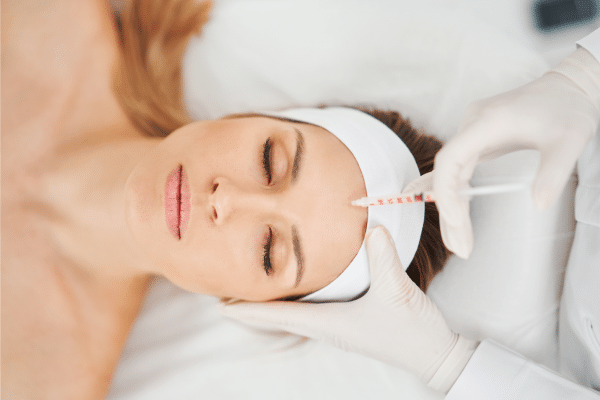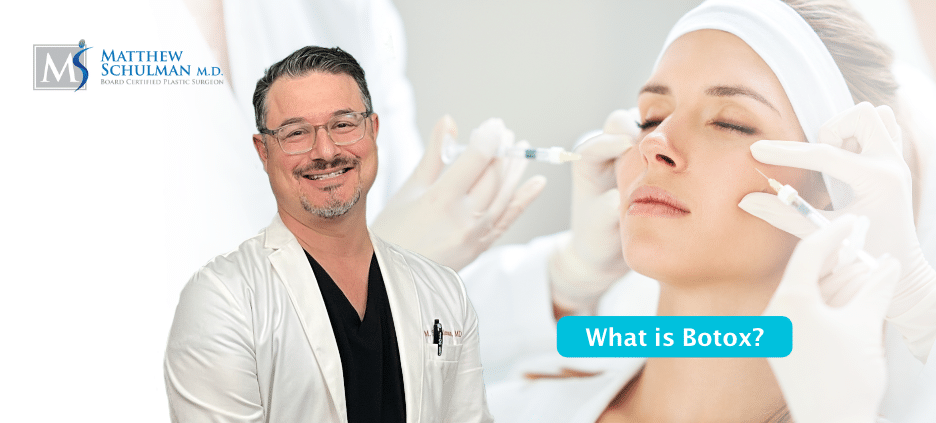Botox, or botulinum toxin, is a medication that is injected into muscles of the face to temporarily paralyze the muscles. Botulinum toxin comes from bacterium clostridium botulinum. By paralyzing the muscles, facial animation is reduced and wrinkles will smooth. Botulinum toxin (Botox) will not paralyze all the muscles of the face. Botulinum toxin only affects the very specific area it is injected into. A skilled injector knows the right injection site to inject very small amounts of the toxin, thereby targeting the muscles that are causing the frown lines and facial wrinkles that you want to disappear.
The most common areas to inject with botulinum toxin are the forehead, between the eyebrows, and around the eyes. Botulinum toxins injected here can soften or eliminate the forehead lines, the “elevens” between the brows, and the “crow’s feet” on the side of the eyes. The result is a more rested appearance. The effect is temporary with most people get good results for 4 months.
How common are Botox injections?
Botulinum toxin injections remains the most common non-surgical cosmetic procedure in the United States. According to the official statistics of the American Society of Plastic Surgery (ASPS), 7.6 million botox injections were performed in 2019. This represents a 900% increase in the number of botox injections compared to 2000.
The second most common non-surgical cosmetic procedure was fillers, and is a very distant second place at 2.7 million injections for 2019.
What is the right age to start getting Botox?
There really is no right answer to this question, since every person is different. According to the American Society of Plastic Surgery, 1.4 million botulinum toxin injections were performed on men and women between the ages of 30 and 39, compared to only 112,000 on people 20-29. This indicates that age time to start getting Botox injections.
This seems to make sense, since we know that many other non-surgical cosmetic procedures become more common at age 30, such as laser, fillers, and chemical peels. The most botox injections were performed on men and women between age 40 and 54 (4.4 million).
However, since the botulinum toxin is designed to reduce the activity of facial muscles, younger people with very active muscles of facial expression choose botox injections.
How is it administered?
Botulinum toxins are injected into the desired areas using small needles. During each needle stick at the injection site, a very small amount of toxin is injected just beneath the skin. This delivers the botox to the muscle that is causing the frown lines or wrinkles.
Does it hurt?
A very small needle is used, but since it is still injections, you will feel a small pinch and slight burn. However, this is extremely well-tolerated and most women compare it to having their eyebrows plucked.
Does it work right away?
Boulinum toxin takes a few days to a week to work. This is because the toxin works by blocking the nerve impulse to the muscle and this process takes some time.
How long will it last?
Most people report that the results last about 3-4 months. The effect of botulinum toxin wears off slowly, so you may notice that the lines and wrinkles return slowly over the course of several weeks. Botox may last longer in some people and in certain areas of the body.
Can there be complications?
Botox cosmetic injections are a very safe procedure with a very low risk of complications when administered by a qualified doctor such as a board certified plastic surgeon or dermatologist. Because it is administered using a needle, there can be bruising. Also, if the toxin is injected into the wrong area, it can paralyze a muscle that was not intended to be paralyzed. The result will depend on which muscle was mistakenly treated. For example, a botulinum toxin injection into the muscle that keeps the eyelid open can cause the eyelid to droop.
Botox cosmetic injections into the muscles around the mouth may cause difficulty pursing your lips, whistling, or drinking from a straw. The good news is that these complications are temporary and will usually improve as the toxin wears off. More serious complications have been reported when botox from unofficial suppliers have been used. This is why it is important to select a physician who is obtaining their toxin from a reputable supplier and not cheap suppliers who may be providing counterfeit medications.
How much does it cost?
The price for Botox injections will vary depending on several factors: who injects it, where you are located, and how much you require. Obviously, certain areas of the country may have higher or lower prices. A med-spa will likely charge you less than an experienced Board Certified Plastic Surgeon but as with everything, beware or prices that seem too good to be true.
Do I have to keep doing it?
No. You can stop having botox injected at any time. Your wrinkles and lines will return and will not be any better or any worse once you stop your botox cosmetic procedures. Additionally, if you have had botox injections and for whatever reason are not happy with the results, you can just let it wear off and there will be no permanent issues.
How do I know if I need Botox or Fillers?
You may complain of lines and wrinkles, and sometimes botox cosmetic injections are the answer and sometimes it is not. If you have lines and wrinkles that are the result of facial animation (i.e., the lines get worse as you scrunch your face), then botox will relax the muscles and soften the lines. However, if you have deep lines that are not directly related to the muscle animation, then Botox will not help. These lines are commonly between the nose and the mouth (naso-labial lines) and also the lower mouth (marionette lines). Treating these lines requires filler.
Fillers such as Restylane and Juvederm are injected into these lines to fill them and soften them. Your physician should be able to tell you if filler or botox is best for your lines. Commonly, fillers and botox are done together for full correction.
Besides lines and wrinkles, will Botox treat anything else?
One less common, but effective, use for botox is treating hyperhidrosis. Hyperhidrosis, or excess sweating, can occur in the underarms, palms, feet, and scalp. Botox will paralyze the tiny muscle that surround each sweat gland. This will reduce the amount of sweat. There are also other medical conditions that botox has been known to help treat. Other medical conditions that botox treatment has been known to alleviate are chronic migraine, cervical dystonia and overactive bladder. People are suprised to learn that you can get botox injections for migraines or to help with an overactive bladder, but it’s true, the results can be life changing.
Injections of botulinum toxin is approved for this use and treating hyperhidrosis can be life-changing for those who suffer. Excess sweating can be unsightly and commonly cause low self-esteem, and social anxiety.
Are there other names for Botox?

But again, most people use the term “botox” when they are really referring to the active ingredient, botulinum toxin. Even your physician may use the term Botox when really referring to the other products. In our practice, in order to avoid this confusion, we use the term “toxin” to describe all three brands regardless of botulinum toxin type, and only use the term botox when specifically referring to botox brand botulinum toxin.
Get Botox Injections Today!
To learn more about having your botox treatments, or other non-surgical cosmetic treatments in New York City with Dr. Matthew Schulman, please contact our office today.




